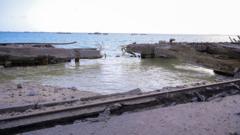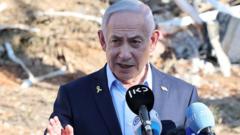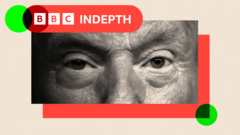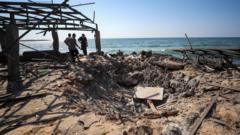As Israel considers direct action against Iran's supreme leader, understanding Khamenei's past and influence becomes crucial.
Khamenei's Shadow: The Man Behind Iran's Power During Heightened Tensions with Israel

Khamenei's Shadow: The Man Behind Iran's Power During Heightened Tensions with Israel
In the backdrop of escalating conflicts in the Middle East, Ayatollah Khamenei remains a pivotal yet elusive figure.
As the conflict between Israel and Iran grows more intense, one key player has notably kept a low profile: Ayatollah Ali Khamenei, Iran's supreme leader. Prime Minister Benjamin Netanyahu recently suggested that an attack on Khamenei might not escalate the existing conflict but could serve to conclude it. In an appearance on ABC News, he stated, "It’s not going to escalate the conflict, it’s going to end the conflict."
Adding to the rhetoric, President Trump delivered a warning to Khamenei via social media, claiming, "we know exactly where he is," while also clarifying that an assassination is currently off the table, as such actions are prohibited under U.S. law. "Our patience is growing thin," he cautioned, suggesting desperation in approaching measures against Iran.
Understanding Khamenei's history sheds light on Iran's ongoing confrontations with Israel. Born in 1939 to a modest family in Mashhad, Khamenei ascended through the ranks during pivotal moments leading to the Iranian Revolution of 1979. Imprisoned multiple times under the oppressive regime of Shah Mohammed Reza Pahlavi, he became a close ally of Ayatollah Ruhollah Khomeini, who led the revolution and established the Islamic Republic.
Khamenei's leadership was solidified following Khomeini's death in 1989, taking on the role of supreme leader and continuing the country’s policy of supporting proxy groups regionally. As tensions rise, the complexities of Khamenei’s leadership and Iran's geopolitical strategies come into sharper focus, highlighting the potential consequences for the wider Middle East.
Adding to the rhetoric, President Trump delivered a warning to Khamenei via social media, claiming, "we know exactly where he is," while also clarifying that an assassination is currently off the table, as such actions are prohibited under U.S. law. "Our patience is growing thin," he cautioned, suggesting desperation in approaching measures against Iran.
Understanding Khamenei's history sheds light on Iran's ongoing confrontations with Israel. Born in 1939 to a modest family in Mashhad, Khamenei ascended through the ranks during pivotal moments leading to the Iranian Revolution of 1979. Imprisoned multiple times under the oppressive regime of Shah Mohammed Reza Pahlavi, he became a close ally of Ayatollah Ruhollah Khomeini, who led the revolution and established the Islamic Republic.
Khamenei's leadership was solidified following Khomeini's death in 1989, taking on the role of supreme leader and continuing the country’s policy of supporting proxy groups regionally. As tensions rise, the complexities of Khamenei’s leadership and Iran's geopolitical strategies come into sharper focus, highlighting the potential consequences for the wider Middle East.




















